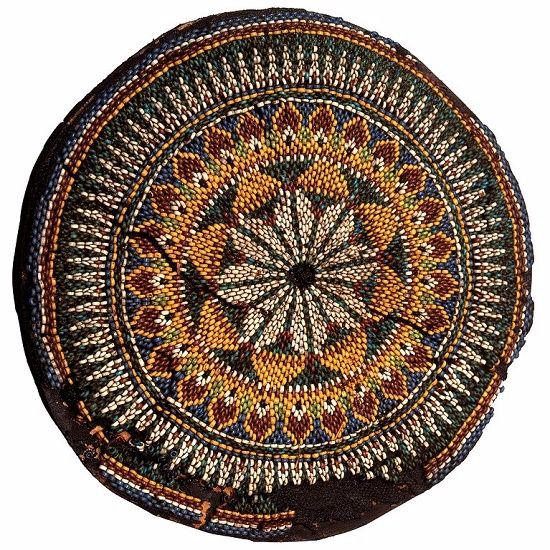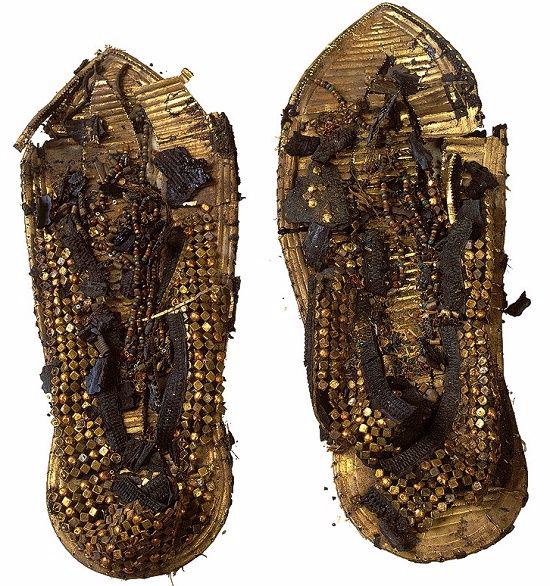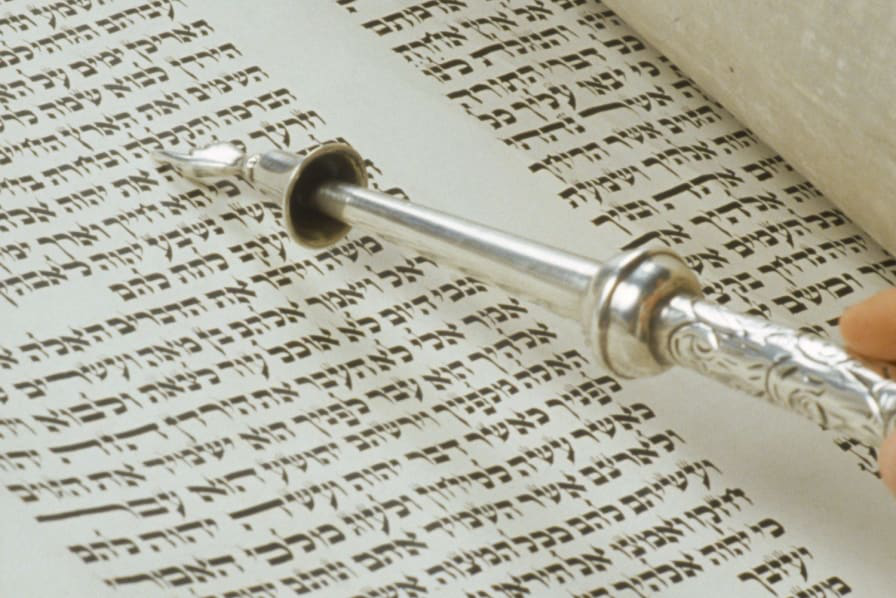(א) וַיְדַבֵּ֥ר יְהֹוָ֖ה אֶל־מֹשֶׁ֥ה לֵּאמֹֽר׃ (ב) דַּבֵּר֙ אֶל־בְּנֵ֣י יִשְׂרָאֵ֔ל וְיִקְחוּ־לִ֖י תְּרוּמָ֑ה מֵאֵ֤ת כׇּל־אִישׁ֙ אֲשֶׁ֣ר יִדְּבֶ֣נּוּ לִבּ֔וֹ תִּקְח֖וּ אֶת־תְּרוּמָתִֽי׃ (ג) וְזֹאת֙ הַתְּרוּמָ֔ה אֲשֶׁ֥ר תִּקְח֖וּ מֵאִתָּ֑ם זָהָ֥ב וָכֶ֖סֶף וּנְחֹֽשֶׁת׃ (ד) וּתְכֵ֧לֶת וְאַרְגָּמָ֛ן וְתוֹלַ֥עַת שָׁנִ֖י וְשֵׁ֥שׁ וְעִזִּֽים׃ (ה) וְעֹרֹ֨ת אֵילִ֧ם מְאׇדָּמִ֛ים וְעֹרֹ֥ת תְּחָשִׁ֖ים וַעֲצֵ֥י שִׁטִּֽים׃ (ו) שֶׁ֖מֶן לַמָּאֹ֑ר בְּשָׂמִים֙ לְשֶׁ֣מֶן הַמִּשְׁחָ֔ה וְלִקְטֹ֖רֶת הַסַּמִּֽים׃ (ז) אַבְנֵי־שֹׁ֕הַם וְאַבְנֵ֖י מִלֻּאִ֑ים לָאֵפֹ֖ד וְלַחֹֽשֶׁן׃
(1) יהוה spoke to Moses, saying: (2) Tell the Israelite people to bring Me gifts; you shall accept gifts for Me from every person whose heart is so moved. (3) And these are the gifts that you shall accept from them: gold, silver, and copper; (4) blue, purple, and crimson yarns, fine linen, goats’ hair; (5) tanned ram skins, dolphin skins, and acacia wood; (6) oil for lighting, spices for the anointing oil and for the aromatic incense; (7) lapis lazuli and other stones for setting, for the ephod and for the breastpiece.
(י) וָאַלְבִּישֵׁ֣ךְ רִקְמָ֔ה וָאֶנְעֲלֵ֖ךְ תָּ֑חַשׁ וָאֶחְבְּשֵׁ֣ךְ בַּשֵּׁ֔שׁ וַאֲכַסֵּ֖ךְ מֶֽשִׁי׃
(10) I clothed you with embroidered garments, and gave you sandals of dolphin leather-a to wear, and wound fine linen about your head, and dressed you in silks.
מַה שֶּׁהָיָה הוּא שֶׁיִּהְיֶה, עוֹרוֹת תְּחָשִׁים מָה הֵן, רַבִּי יְהוּדָה אוֹמֵר אַלְטִינוֹן. רַבִּי נְחֶמְיָה אוֹמֵר גַּלְטִינוֹן. רַבִּי יוֹחָנָן אוֹמֵר מִין חַיָּה גְדוֹלָה הֶרְאָה הַקָּדוֹשׁ בָּרוּךְ הוּא לְמשֶׁה וְעָשָׂה הֵימֶנָּה צֹרֶךְ הַמִּשְׁכָּן וּגְנָזָהּ. רַבִּי אָבִין אָמַר קֶרֶשׁ הָיָה שְׁמָהּ. תָּנֵי רַבִּי הוֹשַׁעְיָה קֶרֶן אַחַת הָיְתָה לוֹ בְּמִצְחוֹ, שֶׁנֶּאֱמַר (תהלים סט, לב): וְתִיטַב לַה' מִשּׁוֹר פָּר מַקְרִן מַפְרִיס וגו', מַקְרִין תַּרְתֵּי שְׁמַע מִנָּהּ. אָמַר רַבִּי חֲנִינָא בַּר יִצְחָק מַקְרִן כְּתִיב...
“What was is what will be, and what was done is what will be done; and there is nothing new under the sun” (Ecclesiastes 1:9)...
What are taḥash hides? Rabbi Yehuda says: Colored hides. Rabbi Neḥemya says: Ermine. Rabbi Yoḥanan says: The Holy One blessed be He showed Moses a large beast, and he used it for the purpose of the Tabernacle. [God then] stored it away. Rabbi Avin said: Its name was keresh. Rabbi Hoshaya taught: It had one horn on its forehead, as it is stated: “It shall please the Lord better than a horned [makrin] and hooved ox” (Psalms 69:32). But doesn’t makrin indicate two? Rabbi Ḥanina bar Yitzḥhak said: Makrin is written.

What Was the Tachash Covering in the Tabernacle? by Dr. Rabbi Norman Solomon
LXX and Josephus – Hyacinth Blue
Our earliest source for interpretation of the word Tachash is the Septuagint, the ancient Greek translation of the Torah. (The Pentateuch translation dates back to the third century BCE.) Throughout Exodus and Numbers, and in Ezekiel, the Septuagint consistently translates Tachash by derivatives of hyacinth (huakinthos). עורות תחשים is rendered “hyacinth skins” (δέρματα ὑακίνθινα; dermata huakinthina) i.e., hides, presumably of goats or sheep, dyed the color of hyacinths. Tachash, then, is not an animal but a dye. Josephus, too, lists among the materials provided for the Tabernacle “goats’ hair and sheepskins, some dyed blue (huakinthos)” (Antiquities 3:102)...
Badgers
In the Renaissance period, many scholars believed that the original human language was Hebrew, and that other languages retained elements of it, if corrupted (after all, gamal and camel are the same word, denoting the same animal). Someone noticed that the consonants T, Ḥ, Š of tachash resemble D, CH, S in German Dachs (‘badger’). Accordingly, Martin Luther, possibly on the advice of his friend and supporter, the humanist Georg Spalatin, translated tachash as Dachsfelle (“badger skins”) (Dalley 2000, 1). Luther’s German translation appeared in 1534, and influenced translations into other European languages including English.
Sea Mammals
The German scholar Gesenius, the first edition of whose Hebrew Lexicon appeared in 1812, offered “seal” as a possible translation, on the basis of Arabic تُخَسْ tuḥash “porpoise,” explaining that the ancient Hebrews would have used this term as a catch-all for many different creatures that “they neither knew nor distinguished with accuracy.” In 1907, Oxford’s Brown, Driver, Briggs Hebrew and English Lexicon of the Old Testament suggested “porpoise.” Nevertheless, in keeping with Genesius’ suggestion that the Hebrews were merely “approximating” with this term, “porpoise” has been modified by subsequent translators of the Bible to assorted aquatic mammals—not only Gesenius’ “seals” but “dolphins” (a kind of porpoise at least) and even “dugongs.”

Dr Gillian Eastwood-Vogelsang in Leiden, working on the clothing in the tomb of Tutankhamun, has identified specific items imported from western Asia, by certain features of design. One of those items consists of beaded sandals which she describes as ’embellished with an intricate design of gold bosses and beadwork in carnelian, turquoise and possibly lapis lazuli’.
In the Amarna letter EA 22 the Mittanian king sent to Akhenaten one pair of duhsu-shoes, studded with ornaments of gold, of hiliba stone, etc. If duhsu here means some kind of beadwork, the description would match not only Tutankhamun’s sandals but also certain beaded objects which have been found intact on excavations in Mesopotamia. (Dalley 2000, 12)

Once, there were unicorns… by Kohenet Yael Tischler 2020
In this same text, Rabbi Meir says that the tachash, the unicorn, “came to Moses’s hand just for the occasion and he made the [covering of] of the tabernacle, and then it was hidden (נגנז – nignaz).” I shared this text with my friend, Yael Roberts, who is an amazing Jewish educator and artist – and she had a reading of this that broke my heart. You realise that means they went extinct, she said. From us using them. We killed the tachashim to make the mishkan and then there weren’t any left.
Viewed this way, the tale of the tachashim – the unicorns – is tragic. Once, there might have been magical creatures that roamed the earth, but then we killed them all in the name of creating sacred space.
The word translated above as “was hidden” is “נגנז – nignaz,” which is the passive version of a fascinating root in Hebrew (גנז – gimmel.nun.zayin), which has many different meanings. According to the Jastrow (a dictionary used to navigate early Rabbinic texts), it can mean “to disappear,” “to remove from sight,” or “to be suppressed,” which supports the reading that the tachashim went extinct because of human usage. However, it can also mean “to cut off,” “to set aside,” “to save,” or my personal favourite, “to hide (in order to prevent desecration).” This is also the same root as the word “גניזה – geniza,” the name given to places where Jewish sacred texts are stored once they are no longer in use. In Jewish tradition, Hebrew texts that contain Divine names are considered too holy to just throw out or recycle after we’re finished with them, so we bury them, with the same tenderness with which we’d bury living things. The texts remain in a geniza for safekeeping until they can be buried (and sometimes over the long-term). In some instances, a geniza can mean a treasury (Pesachim 118b), which is unsurprising, given how much we as a people treasure our words.
So, it’s possible that Rabbi Meir’s suggestion means that human behaviour caused the extinction of the tachashim, but it’s also possible that the building of the Tabernacle, which caused a threat to the tachash population, precipitated a need to protect them. Was the result of tachash overuse the creation of a “geniza” for them, a space to hide them in order to prevent their desecration? I’m imagining the ancient version of an animal sanctuary, meant to save our endangered unicorn friends.
Our tradition offers a dynamic tension: on the one hand, we have the concept of tsaar ba’alei chayim, the injunction to minimise animal suffering, and on the other hand, we do have a very clear tradition of animal products being used for ritual purposes. The tachashim are only one example; those reading this article probably picked up that there were ram skins used for the mishkan, as well, and that’s before facing the truth that the mishkan was used as a place of animal sacrifice, as was the Temple in Jerusalem after that. Before the destruction of the Temple necessitated the innovation of the use of words for prayer, sacrifices, including the sacrifice of animals, were how our ancestors prayed. We don’t make animal sacrifices any more for the most part (though the tradition of kaparot remains in some communities), but we do use ritual objects that traditionally are made from animal products – Torah scrolls, tefillin, mezuzot, tzitzit, shofars and more. It can be a difficult decision for the Jewish vegan to reconcile their beliefs about protecting animals with the ritual practices of their people. I believe that the way forward is a creative approach – a dance that honours our tradition, as well as our desire to create a “geniza”, a protective space, for the tachashim of today.





